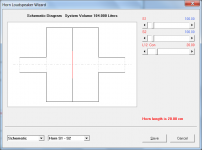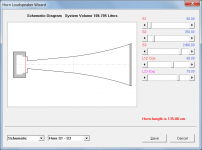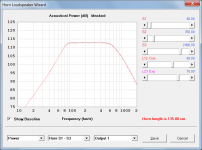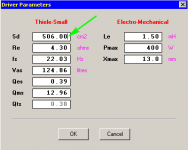@ David McBean
Hi, sorry to bother you with my previous post, & yes it was me ! I wasn't used to using Ctrl+K or Ctrl+D & initially the description of "Multiple Speakers" from Ctrl+K or Tools seemed as if it meant Multiple loudspeakers, as in Multiple drivers. I think it would less confusing, to some/newbies anyway, if the description was changed to Multiple Boxes.
Unless i've missed it, an Undo/Redo feature would be very useful. This would be to Undo/Redo up to x amount of changes we've just made in succession whilst experimenting within the SAME project.
Regards
@ Mark
Onwards towards 1M, Congrats DMB 🙂
Hi, sorry to bother you with my previous post, & yes it was me ! I wasn't used to using Ctrl+K or Ctrl+D & initially the description of "Multiple Speakers" from Ctrl+K or Tools seemed as if it meant Multiple loudspeakers, as in Multiple drivers. I think it would less confusing, to some/newbies anyway, if the description was changed to Multiple Boxes.
Unless i've missed it, an Undo/Redo feature would be very useful. This would be to Undo/Redo up to x amount of changes we've just made in succession whilst experimenting within the SAME project.
Regards
@ Mark
Onwards towards 1M, Congrats DMB 🙂
Provided that the airway is not unduly obstructed, the impact on the overall result should not be great.
I figured as much.
I was thinking of trying to figure out a way of just treating the last fold in the designed TH as volume of air, subtracting the volume occupied by the driver, then retooling the TH model to reflect the new volume in that section as a way of simulating the effect, but maybe it's best to avoid the issue altogether by designing the TH with a large mouth 🙂
Forgive me if there's an obvious reason for not implementing it, but with the recent addition of a series tuned BP6 wizard would it not make sense to also include a parallel tuned BP6 wizard?
Hi Zero D,
Excellent - thanks for letting me know!
Incidentally, your post was no bother at all. I like to get feedback on all Hornresp operating problems - even when it sometimes turns out that they are not due to bugs.
I settled on Multiple Speakers rather than Multiple Boxes, Multiple Enclosures or Multiple Cabinets, because it was a generic term that seemed to be more appropriate when describing arrays of multiple straight-axis horns, for example.
I can certainly see how it could be confusing, however - like lots of other things in Hornresp 🙂.
I agree that it would be very useful, however I suspect that it could be extremely difficult to implement. As far as I can see, it would be necessary to keep track of all keystrokes and the input boxes to which they applied. I have no idea how to go about doing this, particularly as different input forms can be used.
It is of course possible to temporarily store and recall up to four sets of Loudspeaker Wizard data, using the Memory functionality.
Thanks. Out of interest I checked how many posts I have made here - including this one, the number currently stands at 1866, out of a total of 5605 🙂.
Kind regards,
David
Hi, sorry to bother you with my previous post, & yes it was me !
Excellent - thanks for letting me know!
Incidentally, your post was no bother at all. I like to get feedback on all Hornresp operating problems - even when it sometimes turns out that they are not due to bugs.
I think it would less confusing, to some/newbies anyway, if the description was changed to Multiple Boxes.
I settled on Multiple Speakers rather than Multiple Boxes, Multiple Enclosures or Multiple Cabinets, because it was a generic term that seemed to be more appropriate when describing arrays of multiple straight-axis horns, for example.
I can certainly see how it could be confusing, however - like lots of other things in Hornresp 🙂.
Unless i've missed it, an Undo/Redo feature would be very useful. This would be to Undo/Redo up to x amount of changes we've just made in succession whilst experimenting within the SAME project.
I agree that it would be very useful, however I suspect that it could be extremely difficult to implement. As far as I can see, it would be necessary to keep track of all keystrokes and the input boxes to which they applied. I have no idea how to go about doing this, particularly as different input forms can be used.
It is of course possible to temporarily store and recall up to four sets of Loudspeaker Wizard data, using the Memory functionality.
Onwards towards 1M, Congrats DMB 🙂
Thanks. Out of interest I checked how many posts I have made here - including this one, the number currently stands at 1866, out of a total of 5605 🙂.
Kind regards,
David
but maybe it's best to avoid the issue altogether by designing the TH with a large mouth 🙂
Hi Brian,
Sounds like a sensible approach to take, provided that the larger system size overall, does not become a further issue 🙂.
Generally, the bigger the mouth, the smoother the response.
Kind regards,
David
Forgive me if there's an obvious reason for not implementing it, but with the recent addition of a series tuned BP6 wizard would it not make sense to also include a parallel tuned BP6 wizard?
Hi zettairyouiki,
A wizard was not developed specifically for parallel-tuned 6th order bandpass enclosures because the configuration can already be simulated using the standard Loudspeaker Wizard.
Kind regards,
David
Attachments
I agree that it would be very useful, however I suspect that it could be extremely difficult to implement. As far as I can see, it would be necessary to keep track of all keystrokes and the input boxes to which they applied. I have no idea how to go about doing this, particularly as different input forms can be used.
I believe just keeping track of each actual change to a record (not every single keystroke in an input box) would get us a long way. Limiting Undo/Redo to the record that is currently edited is perhaps the most practical, and wouldn't be a big restriction. My thought is that whenever a field is updated, or a configuration is changed, it would be stored. Perhaps a second temporary .dat file that could store changes in the record as a series of records, where you could roll back as desired. That would of course use more storage space than necessary, but a Hornresp record isn't exactly big by modern standards 🙂
-Bjørn
Hornresp record isn't exactly big by modern standards 🙂
-Bjørn
I'd still use it even if the save file was 5 gigs, haha.
Originally Posted by David McBean
I like to get feedback on all Hornresp operating problems - even when it sometimes turns out that they are not due to bugs.
Ok, i'll not bother you again, just post 😀
Multiple Boxes/Enclosures/Cabinets would be a nice improvement 🙂
I'm aware of the Memory function 😉
Suggestions
Auto Port etc adjustment addition for HR.
It'd be nice if you could include this. For eg, with a Reflex design in WinISD if we change the fb, & it auto adjusts the Port lenth/s. Possibly you could this also do this for other designs, so when we altered the fb, it auto adjusts other dimensions, for eg, Length/Width/Depth of the internals. Maybe this could be coded so we could say freeze any 1 or 2 of the 3 dimensions at a time in turn, to compare the results ?
Grille
Also, i wonder if it's possible to account for us having a grille covering a mouth/face etc ? If we could enter the % of free/open air area it has, which we can get from manufactures, this would enable us to see any difference/s with/out a grille *
Regards
I can tell you from experience that you have to cover a great deal of your horn mouth before there is any real difference. I had one client cover all the way to leaving one eighth of the original mouth opening and there was no measurable difference.
I can send you the measurements if you would like to see for yourself.
Can't post them publicly.
I can send you the measurements if you would like to see for yourself.
Can't post them publicly.
@ Mark
Re Grilles.
As there has been some discussions about what effect they might have, i thought it could be useful to be able to sim it, then we would All know for sure 😉
Sure, PM me the info Please 🙂
Re Grilles.
As there has been some discussions about what effect they might have, i thought it could be useful to be able to sim it, then we would All know for sure 😉
Sure, PM me the info Please 🙂
I believe just keeping track of each actual change to a record (not every single keystroke in an input box) would get us a long way.
Hi Bjørn,
Thanks for your thoughts. I might try to investigate the possibility if I get a chance.
It doesn't seem to have much to do with horn loudspeaker simulation though - more an exercise in computer programming 🙂.
Kind regards,
David
Hi Zero D,
It's not going to happen. You are just going to have to remember the difference between Driver and Speaker, as defined in Hornresp.
Another thing that's not going to happen.
Remember, Hornresp is primarily a horn loudspeaker simulation program.
As Mark says, at bass frequencies the effect of a fabric grille will be minimal. This can be readily shown by including a thin layer of suitably absorbent material at the horn mouth.
Kind regards,
David
Multiple Boxes/Enclosures/Cabinets would be a nice improvement 🙂
It's not going to happen. You are just going to have to remember the difference between Driver and Speaker, as defined in Hornresp.
Auto Port etc adjustment addition for HR.
Another thing that's not going to happen.
Remember, Hornresp is primarily a horn loudspeaker simulation program.
Also, i wonder if it's possible to account for us having a grille covering a mouth/face etc ?
As Mark says, at bass frequencies the effect of a fabric grille will be minimal. This can be readily shown by including a thin layer of suitably absorbent material at the horn mouth.
Kind regards,
David
Attachments
@ David McBean
Re - Multiple Enclosures & Auto Port etc adjustment
OK.
Re - Grille
I was more concerned with simming Metal Grilles, & the possible amount of air flow restriction they might cause @ bass f's ? Also if any MF/HF irregularities etc may be caused with them in place ? Richard Small in one of his papers noted that, placing a restriction in a drivers path can cause either a postive or negative effect ! So i think it may be beneficial for us to see Exactly what may happen in Sim, before we lash out $ & build 😉
*
For those who might prefer a Help File in a PDF, i've taken the liberty of converting the HR .HLP into one.
Re - Multiple Enclosures & Auto Port etc adjustment
OK.
Re - Grille
I was more concerned with simming Metal Grilles, & the possible amount of air flow restriction they might cause @ bass f's ? Also if any MF/HF irregularities etc may be caused with them in place ? Richard Small in one of his papers noted that, placing a restriction in a drivers path can cause either a postive or negative effect ! So i think it may be beneficial for us to see Exactly what may happen in Sim, before we lash out $ & build 😉
*
For those who might prefer a Help File in a PDF, i've taken the liberty of converting the HR .HLP into one.
Attachments
Hi Zero D,
Accurately simulating the above effects, particularly MF/HF irregularities caused by the design of the grille structure itself, is not something that Hornresp can do.
It would be safe to say however, that provided that the grille material chosen is typical of that normally used on loudspeakers, the effect on overall performance should be minimal.
Kind regards,
David
I was more concerned with simming Metal Grilles, & the possible amount of air flow restriction they might cause @ bass f's ? Also if any MF/HF irregularities etc may be caused with them in place ?
Accurately simulating the above effects, particularly MF/HF irregularities caused by the design of the grille structure itself, is not something that Hornresp can do.
It would be safe to say however, that provided that the grille material chosen is typical of that normally used on loudspeakers, the effect on overall performance should be minimal.
Kind regards,
David
For some reason i can't backspace in these boxes in THIS window ?
Hi Zero D,
You need to update your version of Hornresp. Post #5492 refers.
http://www.diyaudio.com/forums/subwoofers/119854-hornresp-550.html#post4352233
Kind regards,
David
Originally Posted by David McBean
Accurately simulating the above effects, particularly MF/HF irregularities caused by the design of the grille structure itself, is not something that Hornresp can do.
Pity, but OK.
You need to update your version of Hornresp. Post #5492 refers
That did it, Thanx 🙂
- Home
- Loudspeakers
- Subwoofers
- Hornresp




